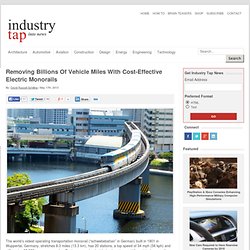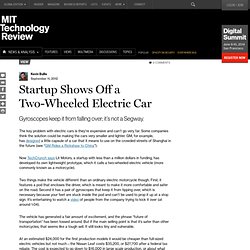

Wireless EV Charging on the Move! The only real problems electric cars have nowadays are their (very) limited range and the bulk of their batteries denting performance and compromising driving dynamics. However, both these problems could be eliminated in one fell swoop with the introduction of wireless charging. Energy Dynamics Lab, a research organization owned by the Utah State University, is working on a solution to the problem faced by all electric cars. They are developing a system to charge EVs through some sort of electrical grid/network embedded in the roadway. This would make EV ownership and driving a much more pleasurable experience. Currently, they have successfully wirelessly charged an electric car while it’s stationary. Removing Billions Of Vehicle Miles With Cost-Effective Electric Monorails.
The world’s oldest operating transportation monorail (“schwebebahan” in German) built in 1901 in Wuppertal, Germany, stretches 8.3 miles (13.3 km), has 20 stations, a top speed of 34 mph (56 kph) and still carries 82,000 passengers a day.

Engineers used a double-track system and the original monorail cars were the first all-steel transit vehicles in history. The Japanese built a dual track dual platform monorail system in Tokyo for the 1964 Summer Olympic Games because the Ministry of transportation wanted to avoid the cost of land acquisition. Hitachi was called upon to develop a high-capacity transit system “in the air” because airspace was free and without congestion.
China rolls out electric vehicle scheme to combat smog. At the push of a button, public can borrow cars from dispensing stationsCars reach speeds of 75mph and can travel for around 50 miles per chargeOperator, Kandi Technologies, has opened two EV vending machines in Hangzhou and has plans to open another 10 this year By Ellie Zolfagharifard Published: 10:08 GMT, 30 January 2014 | Updated: 16:06 GMT, 30 January 2014 China’s love-affair with the car has caused the country to suffer some of the world’s worst air quality.

But now an innovative car vending machine has been unveiled in Hangzhou, on the the south-eastern coast, that could help combat the problem. With just the push of a button, commuters can drive away in an electric car operated by Kandi Technologies. Scroll down for video The tiny cars - manufactured by Volvo's owners Geely - reach a top speed of 75mph and can travel for around 50 miles per charge. Electric Cars : Breaking News, Photos, & Videos - Green Car Reports. Electric vehicles. UWS solar car takes up the challenge - Solar Power Blog. Here at SolarQuotes HQ we like to keep you updated on solar power technology.

From the latest in PV development, to who’s big in solar farms, to breakthroughs in solar panels, we try to keep you, the reader, right on the money in terms of the latest solar energy moving and shaking. In keeping with this tradition we thought we’d pop our head in to see how development on the University of Western Sydney’s solar car challenge was shaping up. Indian Government Announces Eight-Year Plan for Green Vehicle Adoption. Vehicles By Nicholas Katers | Indian Government Announces Eight-Year Plan for Green Vehicle Adoption.

Startup Shows Off a Two-Wheeled Electric Car. The key problem with electric cars is they’re expensive and can’t go very far.

Some companies think the solution could be making the cars very smaller and lighter. GM, for example, has designed a little capsule of a car that it means to use on the crowded streets of Shanghai in the future (see “GM Rides a Rickshaw to China”). Now TechCrunch says Lit Motors, a startup with less than a million dollars in funding, has developed its own lightweight prototype, which it calls a two-wheeled electric vehicle (more commonly known as a motorcycle). Two things make the vehicle different than an ordinary electric motorcycle though. First, it features a pod that encloses the driver, which is meant to make it more comfortable and safer on the road. Electric Bubble Car Could Change Our Idea of Electric Cars. Poop Powered Cars; the Smell of the Future? Before I begin I would like to tell a story.

To do this I ask you to step into my metaphorical time machine and travel back with me through the murky mist to ten years ago when I was a fresh faced sprog, just beginning life at secondary school. It was here that I met my first science teacher, who, for want of a better word, was a bit of a nutcase. She used to tell us that when she went to use the bathroom, she did not flush away her waste like every other non-loopy individual, but instead stored it at the bottom of her garden so she could later power her car. At the time I dismissed her claims as the insane murmurings of a crackpot teacher who had either been exposed to too many children or had been locked away in the stationary cupboard for too long.
But as it turns out, she was actually on to something… Ladies and Gentleman, the Bio-Bug Please say hello to the Bio-Bug, a car that runs solely on, yes you guessed it, poop. ‘That’s all well and good’ I hear you say, ‘but what about the smell?’